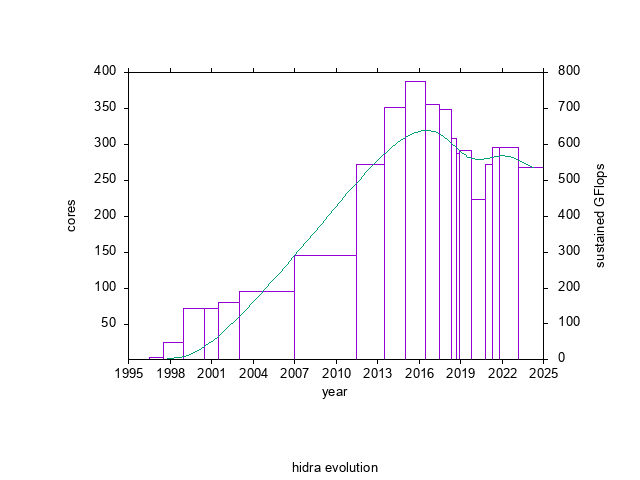HIDRA: FROM THE BEGINNING UNTIL NOW
From 1998 HIDRA is growing and changing:
- The first expansion was in 2000; we add 24 computing nodes and a new
100Base-T switch and we made a system reinstallation using the Debian distribution.
With the expasion we can achieve a teoretical peak of 30GFlops ans a
sustained performance of 10GFlops.
- In 2001 some of the original nodes were sustituted by 8 new powerful ones
to reach a peak of 32GFlops and a sustained throughput of 12GFlops.
- In the next year all the oldest nodes were changed by 12 new nodes
with dual Athlon @ 1.6GHz (doubling the clock speed!). At this moment, the 40
computing nodes had a sustained performance of 24GFlops (with theoretical peak
of 74GFlops). But the room has no space to grow adding more nodes.
- Because the lack of space, in 2004 we had done a 'restyling' moving from
desktop boxes to rack-mounted cases, adding a new cooling system and changing
the network to Gigabit Ethernet. With 32 nodes in two racks and 16 old desktop
boxes the computer power was 240GFlops (with a peak of 655GFlops).
- We took benefit of growing and the subsequent years the cluster was
increased upto 73 computing nodes (146 cores) with a peak of 845GFlops and 310 GFlops of sustained performance.
The actual (Mar 2024) structure of HIDRA is:
- The master node is a 2-core Xeon 5150 @ 2.66GHz with 2GB of RAM and
the storage function is performed by a
server with 8-core Xeon @ 2.1GHz with 32GB of RAM and a
5.5TB RAID6 system shared across the cluster.
All the network components are now Gigabit
- We have 15 computing nodes with 258 real cores (536 virtual
cores using the HyperThreading capability).
Actually, the peak performance is about 1.382TFlops but the sustained one (with
real jobs of the group) is around 0.48TFlops.

 Back to HIDRA home page
Back to HIDRA home page

